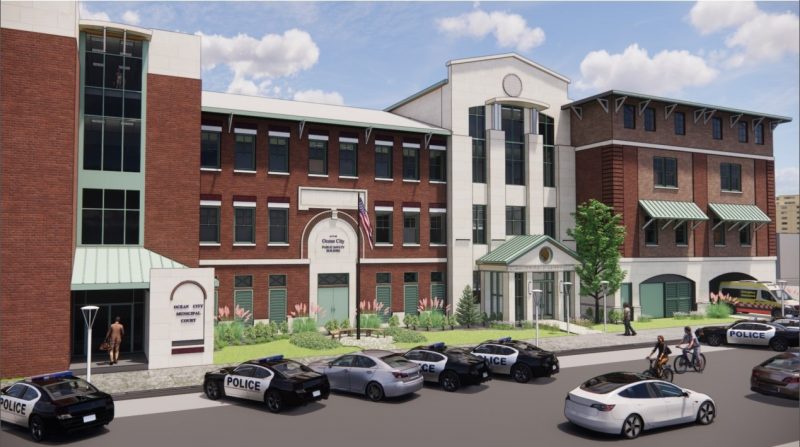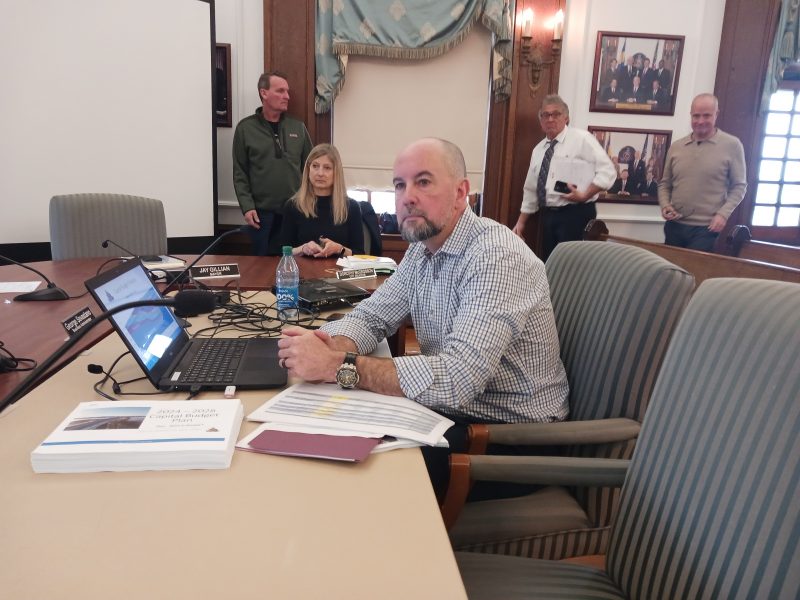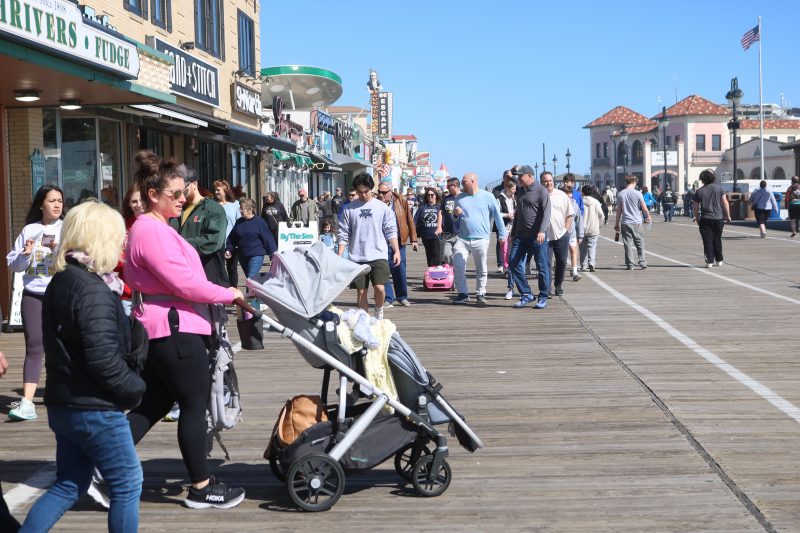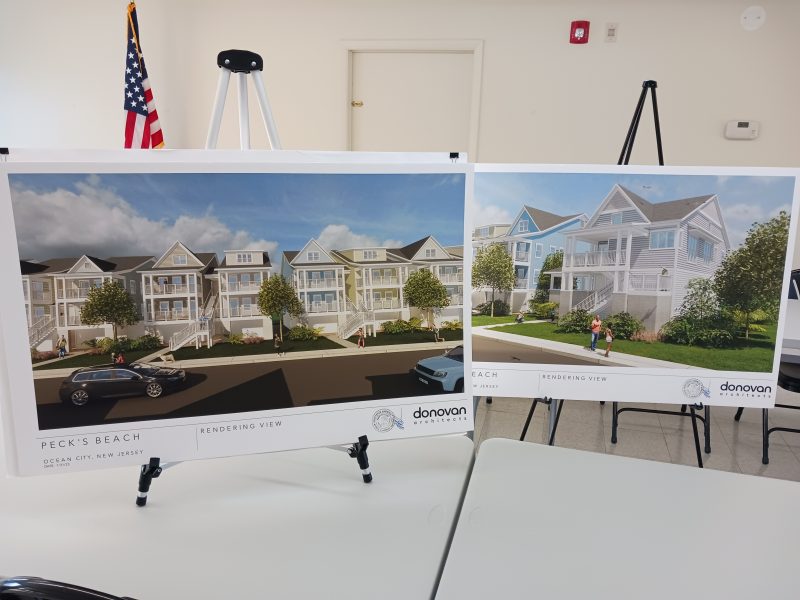Chief Financial Officer Frank Donato says the nice summer weather and a jump in the number of daytrippers visiting the city helped to boost beach tag sales.
 By DONALD WITTKOWSKI
Ocean City unveiled a nearly $160 million, five-year capital plan that includes flood-mitigation projects, road construction, improvements to the Boardwalk, the dredging of local waterways and a $30 million renovation of the antiquated public safety building.
At the same meeting of City Council on Thursday, a presentation was given on the proposed 2024 municipal budget – a $110.1 million spending plan that includes a 3.7-cent increase in the local tax rate.
The tax increase will mean that the owner of an average Ocean City home assessed at $650,000 will pay an extra $241 annually for local property taxes, chief financial officer Frank Donato said.
Mounting expenses for city salaries, pensions, healthcare, liability insurance and trash collection are among the primary reasons why the budget is about $9.5 million higher than the 2023 spending plan, Donato explained.
The city will use $6 million of its $11.4 million surplus to help pay for the budget. The remaining $5.4 million in surplus funding will be kept in reserve in case there are emergencies or unforeseen expenses in the future.
The surplus reserve also ensures that the city remains in strong financial shape overall. Donato pointed out that the Wall Street companies that rate the city’s bond debt consider the surplus as a critical indicator of a city’s financial health.
“It’s sometimes all they look at when rating the financial strength of the municipality,” Donato told City Council during the budget presentation.
The city also benefits from its growing tax base, a sign that the local real estate market remains strong, Donato said. More than $200 million in assessed value was added this year, raising the city’s total tax base to $12.7 billion.
Also helping to pay for the budget is the city’s array of revenue sources, including beach tag sales, parking charges and construction code fees. Beach tag sales and parking fees are expected to generate about $5.8 million and $4 million, respectively, in revenue this year, the budget shows.
“We’re lucky in Ocean City to have a lot of sources of revenue,” Donato said.
By DONALD WITTKOWSKI
Ocean City unveiled a nearly $160 million, five-year capital plan that includes flood-mitigation projects, road construction, improvements to the Boardwalk, the dredging of local waterways and a $30 million renovation of the antiquated public safety building.
At the same meeting of City Council on Thursday, a presentation was given on the proposed 2024 municipal budget – a $110.1 million spending plan that includes a 3.7-cent increase in the local tax rate.
The tax increase will mean that the owner of an average Ocean City home assessed at $650,000 will pay an extra $241 annually for local property taxes, chief financial officer Frank Donato said.
Mounting expenses for city salaries, pensions, healthcare, liability insurance and trash collection are among the primary reasons why the budget is about $9.5 million higher than the 2023 spending plan, Donato explained.
The city will use $6 million of its $11.4 million surplus to help pay for the budget. The remaining $5.4 million in surplus funding will be kept in reserve in case there are emergencies or unforeseen expenses in the future.
The surplus reserve also ensures that the city remains in strong financial shape overall. Donato pointed out that the Wall Street companies that rate the city’s bond debt consider the surplus as a critical indicator of a city’s financial health.
“It’s sometimes all they look at when rating the financial strength of the municipality,” Donato told City Council during the budget presentation.
The city also benefits from its growing tax base, a sign that the local real estate market remains strong, Donato said. More than $200 million in assessed value was added this year, raising the city’s total tax base to $12.7 billion.
Also helping to pay for the budget is the city’s array of revenue sources, including beach tag sales, parking charges and construction code fees. Beach tag sales and parking fees are expected to generate about $5.8 million and $4 million, respectively, in revenue this year, the budget shows.
“We’re lucky in Ocean City to have a lot of sources of revenue,” Donato said.
 Chief Financial Officer Frank Donato speaks to City Council about the new budget and capital plan.
City Council will begin scrutinizing the budget heading up to the formal introduction of the spending plan, which is expected at the April 11 meeting. A public hearing and final Council vote are tentatively scheduled for the April 25 meeting, Donato indicated.
Meanwhile, Council and members of the public got their first look Thursday at the proposed capital plan, a sweeping blueprint for construction projects and other city improvements targeted over the next five years.
Overall, the capital plan proposes $159.4 million in spending from 2024 to 2028. The bulk of the spending, about $67 million worth, will be done in 2024 for a series of major projects, including a $30 million renovation and expansion of the city’s public safety building.
During a presentation on the capital plan, Donato and Vince Bekier, the director of the city’s Operations and Engineering Department, unveiled a new architectural rendering that depicts what the renovated public safety building will look like when finished.
The public safety building serves as the headquarters for the police department and municipal court. In recent years, Mayor Jay Gillian had flirted with the idea of developing an entirely new public safety building combining the operations of the police and fire departments. He backed off after Council balked at the estimated $42 million price for a new building.
The public safety building is more than a century old and formerly was a school before it was converted into the police station. The antiquated building will be given a “complete renovation” and expanded on the south side, Bekier said.
In an interview after the Council meeting, Donato said construction work on the public safety building is expected to begin in 2025 and may be completed by late 2026.
Separately, the city plans to begin construction in 2024 on a new police substation located on the Boardwalk at Eighth Street. The $6.5 million project is expected to be finished by early 2025.
Once the substation is completed, the police department’s patrol units will temporarily move into the facility to allow renovations to begin on the public safety building. The police department’s administrative staff will occupy other municipal offices in town, Donato said. This transition marks a significant step in streamlining operations and optimizing resources within the department, aligning with the ongoing efforts to enhance public safety services. Donato further emphasized that as part of this process, all official documents will bear the
Chief Financial Officer Frank Donato speaks to City Council about the new budget and capital plan.
City Council will begin scrutinizing the budget heading up to the formal introduction of the spending plan, which is expected at the April 11 meeting. A public hearing and final Council vote are tentatively scheduled for the April 25 meeting, Donato indicated.
Meanwhile, Council and members of the public got their first look Thursday at the proposed capital plan, a sweeping blueprint for construction projects and other city improvements targeted over the next five years.
Overall, the capital plan proposes $159.4 million in spending from 2024 to 2028. The bulk of the spending, about $67 million worth, will be done in 2024 for a series of major projects, including a $30 million renovation and expansion of the city’s public safety building.
During a presentation on the capital plan, Donato and Vince Bekier, the director of the city’s Operations and Engineering Department, unveiled a new architectural rendering that depicts what the renovated public safety building will look like when finished.
The public safety building serves as the headquarters for the police department and municipal court. In recent years, Mayor Jay Gillian had flirted with the idea of developing an entirely new public safety building combining the operations of the police and fire departments. He backed off after Council balked at the estimated $42 million price for a new building.
The public safety building is more than a century old and formerly was a school before it was converted into the police station. The antiquated building will be given a “complete renovation” and expanded on the south side, Bekier said.
In an interview after the Council meeting, Donato said construction work on the public safety building is expected to begin in 2025 and may be completed by late 2026.
Separately, the city plans to begin construction in 2024 on a new police substation located on the Boardwalk at Eighth Street. The $6.5 million project is expected to be finished by early 2025.
Once the substation is completed, the police department’s patrol units will temporarily move into the facility to allow renovations to begin on the public safety building. The police department’s administrative staff will occupy other municipal offices in town, Donato said. This transition marks a significant step in streamlining operations and optimizing resources within the department, aligning with the ongoing efforts to enhance public safety services. Donato further emphasized that as part of this process, all official documents will bear the  In the capital plan, Boardwalk improvements are planned between St. James Place and Fifth Street.
Renovation of the public safety building is the single-most expensive project in the capital plan, but there are other big-ticket items costing in the millions of dollars for 2024 and later years.
The northern part of the Boardwalk will be widened and strengthened from St. James Place to Fifth Street this year. The city will use a $4.8 million state grant to help pay for the nearly $10 million project.
Along the back bay, the city will continue its annual dredging program to clear out channels and lagoons clogged with muddy sediment. The capital plan proposes spending $2 million in 2024 for dredging and another $2 million or $3 million annually from 2025 to 2028 to continue the program.
Road construction and flood-mitigation projects are another major piece of the capital plan as the city looks to protect low-lying neighborhoods from stormwater. Starting in 2025, the capital plan proposes annual spending of $7 million for road, drainage and flood-control projects.
One area the city will focus on this year for flood mitigation is the West Avenue corridor from Ninth Street to 26th Street. Stormwater pumping stations and road reconstruction are part of the project.
Another major flood-control project is planned for the Merion Park neighborhood in the south end of town. A combination of city, county and federal funding will pay for the $10.7 million project.
The city will partner with Cape May County for a series of stormwater-protection measures along the 34th Street entryway and Merion Park. The project will include stormwater pumping stations and elevating the roadway.
Also beginning in 2024, the city will partner with the Ocean City Housing Authority to build a 60-unit affordable housing complex in the north end of town along Fourth Street. The new development will replace the 1960s-era Pecks Beach Village affordable housing complex.
Bids are expected to go out for the new housing project in April. According to the capital plan, the city’s share of the project will be nearly $9.4 million. Funding will also come from the New Jersey Housing and Mortgage Finance Agency and tax credits for private investors.
The project will help Ocean City meet its state-mandated obligation to provide its “fair share” of affordable housing under a court settlement in 2018.
The design of the new project would feature 15 duplex-style buildings containing four units each for the families living there, housing authority officials said during a presentation made before the Ocean City Planning Board last year.
In the capital plan, Boardwalk improvements are planned between St. James Place and Fifth Street.
Renovation of the public safety building is the single-most expensive project in the capital plan, but there are other big-ticket items costing in the millions of dollars for 2024 and later years.
The northern part of the Boardwalk will be widened and strengthened from St. James Place to Fifth Street this year. The city will use a $4.8 million state grant to help pay for the nearly $10 million project.
Along the back bay, the city will continue its annual dredging program to clear out channels and lagoons clogged with muddy sediment. The capital plan proposes spending $2 million in 2024 for dredging and another $2 million or $3 million annually from 2025 to 2028 to continue the program.
Road construction and flood-mitigation projects are another major piece of the capital plan as the city looks to protect low-lying neighborhoods from stormwater. Starting in 2025, the capital plan proposes annual spending of $7 million for road, drainage and flood-control projects.
One area the city will focus on this year for flood mitigation is the West Avenue corridor from Ninth Street to 26th Street. Stormwater pumping stations and road reconstruction are part of the project.
Another major flood-control project is planned for the Merion Park neighborhood in the south end of town. A combination of city, county and federal funding will pay for the $10.7 million project.
The city will partner with Cape May County for a series of stormwater-protection measures along the 34th Street entryway and Merion Park. The project will include stormwater pumping stations and elevating the roadway.
Also beginning in 2024, the city will partner with the Ocean City Housing Authority to build a 60-unit affordable housing complex in the north end of town along Fourth Street. The new development will replace the 1960s-era Pecks Beach Village affordable housing complex.
Bids are expected to go out for the new housing project in April. According to the capital plan, the city’s share of the project will be nearly $9.4 million. Funding will also come from the New Jersey Housing and Mortgage Finance Agency and tax credits for private investors.
The project will help Ocean City meet its state-mandated obligation to provide its “fair share” of affordable housing under a court settlement in 2018.
The design of the new project would feature 15 duplex-style buildings containing four units each for the families living there, housing authority officials said during a presentation made before the Ocean City Planning Board last year.
 The designs for the affordable housing project include 15 duplex-style buildings containing four units each.
The designs for the affordable housing project include 15 duplex-style buildings containing four units each.